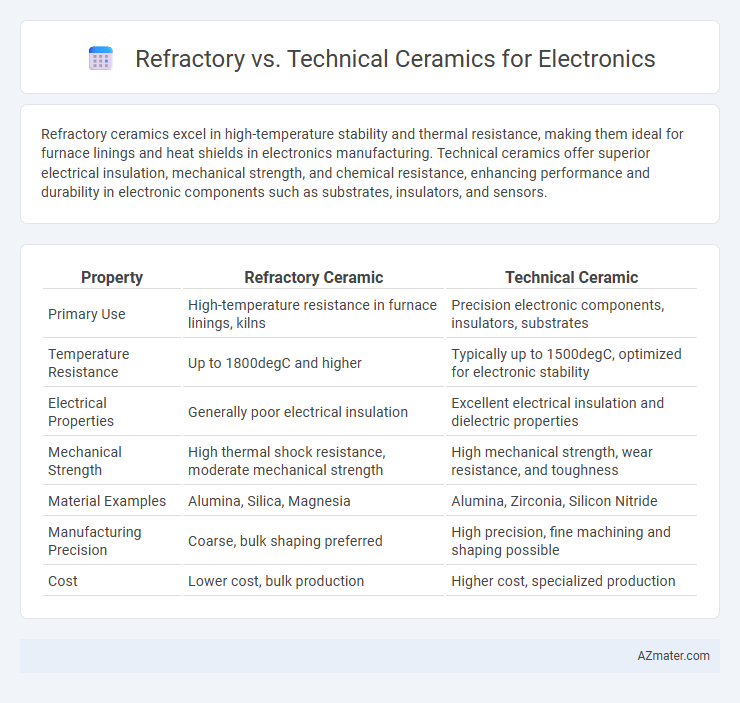Refractory ceramics excel in high-temperature stability and thermal resistance, making them ideal for furnace linings and heat shields in electronics manufacturing. Technical ceramics offer superior electrical insulation, mechanical strength, and chemical resistance, enhancing performance and durability in electronic components such as substrates, insulators, and sensors.
Table of Comparison
| Property | Refractory Ceramic | Technical Ceramic |
|---|---|---|
| Primary Use | High-temperature resistance in furnace linings, kilns | Precision electronic components, insulators, substrates |
| Temperature Resistance | Up to 1800degC and higher | Typically up to 1500degC, optimized for electronic stability |
| Electrical Properties | Generally poor electrical insulation | Excellent electrical insulation and dielectric properties |
| Mechanical Strength | High thermal shock resistance, moderate mechanical strength | High mechanical strength, wear resistance, and toughness |
| Material Examples | Alumina, Silica, Magnesia | Alumina, Zirconia, Silicon Nitride |
| Manufacturing Precision | Coarse, bulk shaping preferred | High precision, fine machining and shaping possible |
| Cost | Lower cost, bulk production | Higher cost, specialized production |
Introduction to Ceramics in Electronics
Refractory and technical ceramics play distinct roles in electronics, with refractory ceramics primarily used for their high-temperature resistance in components like insulators and heating elements. Technical ceramics, also known as advanced ceramics, offer superior electrical, thermal, and mechanical properties suited for semiconductors, sensors, and substrates. These ceramics enhance electronic device performance by providing stability, durability, and efficient thermal management.
Defining Refractory Ceramics
Refractory ceramics are specialized materials designed to withstand extreme temperatures and harsh chemical environments, making them indispensable in high-temperature electronic applications. Unlike technical ceramics, which prioritize electrical insulation, mechanical strength, and precision, refractory ceramics emphasize thermal stability and resistance to deformation under intense heat. These properties enable refractory ceramics to serve crucial roles in electronic components exposed to severe thermal cycles, such as furnace linings and heat shields.
What Are Technical Ceramics?
Technical ceramics, also known as advanced ceramics, are engineered materials designed for high-performance electronic applications due to their exceptional electrical insulation, thermal stability, and mechanical strength. Unlike traditional refractory ceramics, technical ceramics offer precise control over microstructure and purity, enabling enhanced dielectric properties and resistance to wear and corrosion in electronic components. Common examples include alumina, zirconia, and silicon nitride, widely used in substrates, insulators, and semiconductor packages.
Material Composition and Structure
Refractory ceramics, primarily composed of oxides like alumina and zirconia, exhibit high melting points and thermal stability due to their dense polycrystalline microstructure, making them ideal for high-temperature electronic applications. Technical ceramics, such as silicon carbide and silicon nitride, combine unique material compositions with engineered crystalline or amorphous structures that provide enhanced mechanical strength, electrical insulation, and thermal conductivity for precision electronic components. The distinct differences in grain size, phase purity, and bonding type between refractory and technical ceramics directly influence their suitability for specific electronic device requirements.
Thermal Properties Comparison
Refractory ceramics, such as alumina and zirconia, exhibit high melting points and excellent thermal stability, making them suitable for extreme temperature environments in electronics. Technical ceramics, including silicon carbide and aluminum nitride, offer superior thermal conductivity and lower thermal expansion, enhancing heat dissipation and mechanical reliability in electronic components. The choice depends on balancing thermal insulation in refractories against efficient heat transfer in technical ceramics for optimized electronic device performance.
Electrical Insulation Capabilities
Refractory ceramics typically offer high thermal stability and mechanical strength but have lower electrical insulation properties compared to technical ceramics. Technical ceramics, such as alumina and zirconia, are specifically engineered for superior electrical insulation, high dielectric strength, and minimal electrical conductivity, making them ideal for electronic applications. Their optimized microstructure and purity ensure reliable performance in critical components like insulators, substrates, and circuit boards.
Mechanical Strength and Durability
Refractory ceramics exhibit exceptional mechanical strength and thermal shock resistance, making them ideal for high-temperature electronic components exposed to extreme conditions. Technical ceramics, such as alumina and silicon carbide, offer superior hardness, wear resistance, and electrical insulation, ensuring long-term durability in microelectronic devices. The mechanical strength of technical ceramics typically exceeds that of refractories due to their refined microstructure and controlled processing methods.
Common Applications in Electronics
Refractory ceramics such as alumina and zirconia are extensively used in electronics for insulation and thermal management in high-temperature environments, including substrates in power electronics and heating elements. Technical ceramics, encompassing materials like silicon nitride and beryllium oxide, offer superior mechanical strength, thermal conductivity, and electrical insulation, making them ideal for semiconductor packaging, sensors, and circuit boards. Both types are critical in applications requiring durability, temperature resistance, and electrical performance, with refractories mainly supporting thermal stability and technical ceramics enhancing mechanical integrity and electronic functionality.
Cost and Manufacturing Considerations
Refractory ceramics typically offer lower material costs compared to technical ceramics due to simpler manufacturing processes and abundant raw materials. Technical ceramics, designed for high-performance electronic applications, involve complex fabrication techniques like precision machining and sintering, increasing production expenses. Cost-efficiency in electronics manufacturing hinges on balancing refractory ceramics' affordability with the advanced functional properties of technical ceramics.
Choosing the Right Ceramic for Electronics
Refractory ceramics and technical ceramics serve distinct roles in electronics; refractory ceramics, such as alumina and zirconia, excel in high-temperature resistance and thermal stability, making them ideal for insulating components in harsh environments. Technical ceramics, including silicon nitride and aluminum nitride, offer superior electrical insulation, mechanical strength, and thermal conductivity, essential for precision electronic devices and substrates. Selecting the right ceramic depends on the specific application requirements, including thermal management, electrical insulation, mechanical durability, and environmental exposure conditions.

Infographic: Refractory vs Technical ceramic for Electronics
 azmater.com
azmater.com